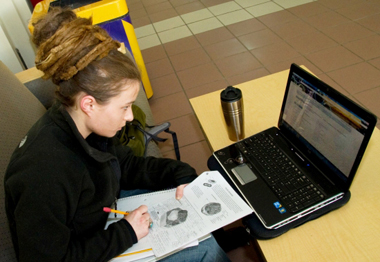Online Education: Impact on Job Seekers and Future Implementation
Q&A with UAlbany School of Education Associate Professor Peter Shea
 |
|
Last year more than six million college students—or one in three U.S. college students—took a fully online course, according to UAlbany Associate Professor Peter Shea. (Photo Mark Schmidt)
|
ALBANY, N.Y. (July 23, 2012) -- With the latest jobs report from the Bureau of Labor Statistics well below the expectations of leading economists, the employment outlook for the U.S. remains precarious. Some analysts speculate that the rise in the unemployment rate is tied to the influx of recent college graduates into the job market, including those who received their degrees through online programs.
Associate Professor of Educational Theory and Practice Peter Shea of UAlbany’s School of Education is an expert in online learning, secondary and higher education. He is principal investigator on a U.S. Department of Education grant to research and develop an online system to support teaching in k-12 settings. Shea discusses the development and future of online education, and the impact for job seekers with degrees from distance learning programs.
Q: What is 'online learning' and how has it evolved since its introduction?
A: Online learning is a form of distance education that uses the Internet to promote interaction between students and content, teachers, and other students. Since its introduction, online learning has evolved in a number of ways. The introduction of standard course management systems (e.g. the Blackboard system) has made the experience more predictable and easier.
 |
|
UAlbany Associate Professor of Education Peter Shea
|
Since the Internet allows for two-way communication, online learning has advantages over older distance education models that relied more on one-way communication or very limited two-way communication. These advantages and the relative ease-of-use of new technologies have created opportunities for increased access, convenience, and flexibility resulting in dramatic growth. Last year more than six million college students—or one in three U.S. college students—took a fully online course.
Q: What are the benefits of online educational programs?
A: The major benefits are increased access, flexibility, and convenience while maintaining quality academics. As student demographics have evolved, the need for non-campus based options for higher education has grown. Older students and students with careers, families, and other obligations are able to accomplish their educational goals without the disruption that might occur with full-time residential study. Again, the research indicates that, on average, learning outcomes are at least equivalent to on-campus study.
Q: How is the delivery of online courses expected to evolve in the future?
A: The recent entry of some elite institutions in the online education space has created a lot of headlines lately. Harvard, MIT, Stanford, and other top institutions have begun to offer course content and instruction for free in what are known as Massive Open Online Courses or “MOOCs.” Plans are in the works to offer certificates for students who complete these courses.
At present, little is known about the effectiveness of online courses that enroll tens of thousands of students at once, as is the case in some MOOCs, but these colleges create interesting questions about the future of credentialing. For example, will there be a new system that competes with the traditional college degree? What are the business models and will they be sustainable? Will these kinds of offerings provide opportunities to students who would otherwise never attend college, and what will be the effect on the employment sector?
Q: How are online degree programs viewed among employers compared with traditional brick and mortar programs?
A: This is a complex issue since perspectives vary widely. While the common perception is that the average online student attends a private for-profit institution (e.g. Phoenix University), this is not accurate. While some for-profit providers suffer from reputational issues which negatively color perception, the average online student is most likely to be enrolled in courses faculty-designed and led at a public institution.
The most popular format is “asynchronous” in which a cohort of students has a semester-based course to which they can log on, interact, ask and answer questions, and complete assignments in a flexible manner. Due dates and time lines exist to keep students on track. The research to date indicates that this form of online instruction is as at least as good as, and in some cases, better than traditional instruction.
Many colleges do not make distinctions on transcripts regarding the modality of instruction in which the student participated. While some employers may have concerns, the research suggests that these may be misplaced, since most degrees don’t indicate that the student studied online. Yet again, reputational issues, whether founded or unfounded do persist and need to be addressed. We can better inform employers about the evidence on the effectiveness of online instruction and raise awareness that reputable accredited online programs are not a cause for concern.
Find out more about UAlbany's Masters Program in Curriculum Development and Instructional Technology.
![]() For more news, subscribe to UAlbany's RSS headline feeds
For more news, subscribe to UAlbany's RSS headline feeds
Educationally and culturally, the University at Albany-SUNY puts "The World Within Reach" for its 17,500 students. An internationally recognized research university with 50 undergraduate majors and 125 graduate degree programs, UAlbany is a leader among all New York State colleges and universities in such diverse fields as public policy, nanotechnology and criminal justice. With a curriculum enhanced by 300 study-abroad opportunities, UAlbany launches great careers. For more information about this globally ranked University, visit https://www.albany.edu/. For UAlbany's extensive roster of faculty experts, visit www.albany.edu/news/experts.shtml.




